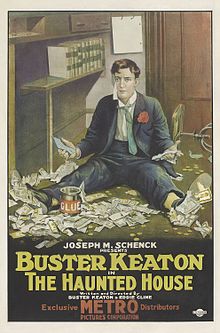The Haunted House (1921 film)
| The Haunted House | |
|---|---|
 Theatrical poster | |
| Directed by | |
| Written by | |
| Produced by | Joseph M. Schenck |
| Starring | |
| Cinematography | Elgin Lessley |
| Distributed by | Metro Pictures |
Release date |
|
Running time | 21 minutes |
| Country | United States |
| Language | Silent (English intertitles) |
The Haunted House is a 1921 American two-reel silent comedy film starring Buster Keaton. It was written and directed by Keaton and Edward F. Cline.[1] The runtime is 21 minutes.
Plot
Keaton plays a teller at a successful bank. Unbeknownst to him, the manager at the bank and his gang are planning on pulling off a robbery and hiding in an old house which they have rigged up with booby traps and effects to make it appear to be haunted. After a mishap that afternoon with Keaton getting glue all over the money and himself, he almost thwarts the gang's robbery but when the owner of the bank walks in and sees Keaton armed with a gun he assumes it was he who tried to rob it. Keaton flees and takes refuge in the old house; however, a troupe of actors from a theatre production are also in the house and are clad in their scary costumes (ghosts, skeletons etc) leading Keaton and the gang of robbers to believe the house actually is haunted. After Keaton has many encounters with the "ghosts" and the house's booby traps, he discovers the scam and the manager is revealed as being behind the robbery. As the manager is about to be taken away, he hits Keaton over the head and knocks him out before escaping. Next we see Keaton being awoken by two angels at the foot of a large stairway which he ascends all the way to Heaven. He asks Saint Peter to be let in but is denied and is sent all the way down to Hell. However, this is all revealed to be a dream sequence as Keaton regains consciousness in the house seconds later.
Cast
- Buster Keaton as Bank Clerk
- Virginia Fox as Bank President's Daughter
- Joe Roberts as Bank Cashier
- Edward F. Cline as Customer in Bank
- Dorothy Cassil as Flirty Bank Customer (uncredited)
- Mark Hamilton as Tallest Ghost (uncredited)
- Natalie Talmadge as Fainting Female Bank Customer (uncredited)
Legacy
Christopher Workman commented, "(The film) belongs to a different, more simplistic era of comedic storytelling. As such it doesn't work too well today...(but) it has a certain amount of naive charm. Even in its day, there wasn't much original about it, given that haunted houses occupied by criminals had been a staple of the genre for nearly two decades already."[2]
See also
References
- ^ "TBK 7: Teller Talks Buster Keaton! + Interview with Teller." Talking Buster Keaton, 13 November 2017.
- ^ Workman, Christopher; Howarth, Troy (2016). "Tome of Terror: Horror Films of the Silent Era". Midnight Marquee Press. p. 237.ISBN 978-1936168-68-2.
External links
- The short film The Haunted House is available for free viewing and download at the Internet Archive.
- The Haunted House at IMDb
- The Haunted House on YouTube
- The Haunted House at AllMovie
- The Haunted House at the International Buster Keaton Society
- 1921 films
- 1921 comedy films
- American films
- American silent short films
- American black-and-white films
- Films directed by Buster Keaton
- American haunted house films
- Films directed by Edward F. Cline
- 1921 short films
- American comedy films
- Films produced by Joseph M. Schenck
- English-language films
- Films with screenplays by Buster Keaton
- Comedy short films
